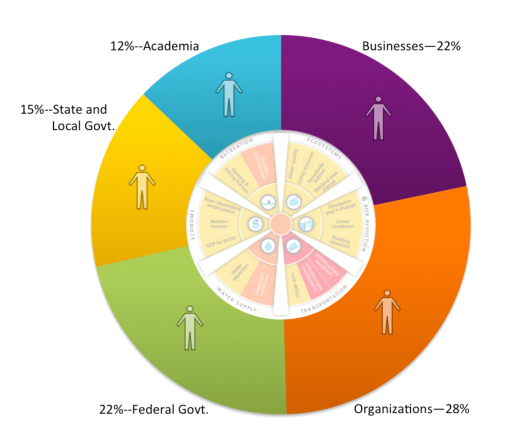The Report Card: A Cooperative Process.
America’s Watershed Initiative has worked with leaders, stakeholders, and experts from more than 400 businesses, organizations, agencies, and academic institutions to develop the report card.
The goal for the Report Card is simple — provide decision makers, watershed leaders and the public with easy-to-understand information about the state of the watershed’s health to aid them in developing a collaborative approach to managing America’s Watershed.
From the start, the groups working together to support America’s Watershed Initiative had three key goals for the report card project:
- Bring together key leaders, stakeholders, and experts representing all of the basins and sectors to develop a single and shared document to measure the current status of six broad goals for the watershed
- Build a report card supported by data that will help us to identify successes, opportunities for improvement, and areas needing additional research
- Use this tool to identify opportunities for collaborations and a more shared vision for the watershed.
America’s Watershed Initiative traveled to every basin and to Washington D.C. for more than a dozen major workshops, meetings and summits paired with webinars to bring together diverse experts with broad perspectives to develop the report card. Each workshop and meeting was different but the importance of the rivers and waters to every sector and in each basin was clear. We received significant feedback after sharing the preliminary report card in the fall of 2015 and convened additional expert review teams to improve upon the preliminary results. This final report card is built upon the entirety of that feedback and engagement. (View/download a more detailed participant report. PDF 2MB.)

700+ Participants
- 400+ businesses and organizations
- 37 states + Canada and Korea
- 140+ Business Organizations
- 145+ Federal Agencies
- 180+ Organizations & Basin Groups
- 100+ State & Local Government Agencies
- 85+ Academic Institutions
In addition to the grades for the six goals and information about each of the basins, the project also includes additional reports, analysis, and background information about data sources and methodology shared on America’s Watershed Initiative website in technical papers and other documents.
The report card is not a goal into itself—it’s a tool to bring together leaders from around the watershed to develop a shared vision for the future and create awareness about the opportunities and challenges that face our states and nation. This shared vision will be used to identify and form partnerships to advance solutions to these critical water management challenges. Knowing what’s important and how to measure it is the foundation to taking collaborative action to improve the watershed.
Support
The Report Card for the Mississippi River Watershed has been developed with the foundational financial support for America’s Watershed Initiative from the Caterpillar Foundation, The McKnight Foundation, Ingram Barge Company and The Nature Conservancy. We also want to thank the many other financial supporters of the AWI 2014 Summit where the preliminary report card was released for feedback.
Report Card Team
Charles Somerville (Ohio River Basin Alliance), Rainy Shorey (Caterpillar, Inc.), Bill Dennison, Jane Thomas, Caroline Donovan, Jane Hawkey, Heath Kelsey, Bill Nuttle, Brianne Walsh (University of Maryland Center for Environmental Science), Jonathan Higgins (The Nature Conservancy), Harald “Jordy” Jordahl (America’s Watershed Initiative), Michael Reuter (The Nature Conservancy), Gretchen Benjamin (The Nature Conservancy), Jay Harrod (The Nature Conservancy), Angela Freyermuth (US Army Corps of Engineers).
The AWI Report Card was developed over two years with significant amount of information and feedback from hundreds of experts and stakeholders throughout the watershed and nation. View a comprehensive Report Card technical paper that includes data sources, calculations and analysis.
